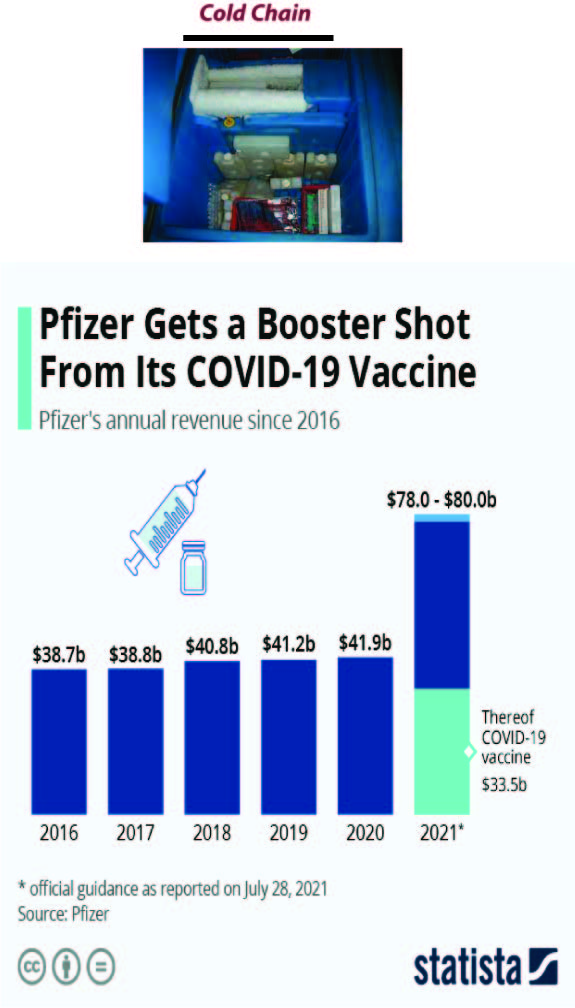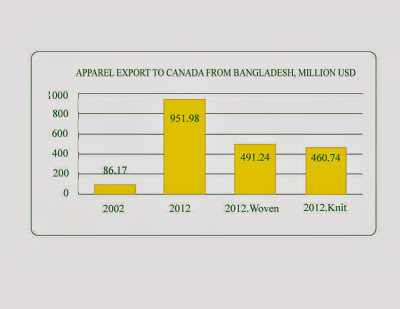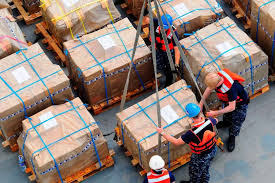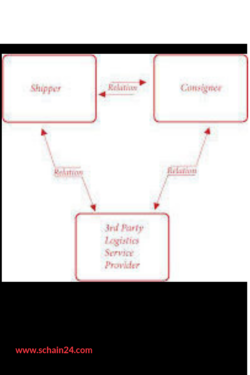Abstract
Existing amenities are not enough to store, and deliver a large volume of vaccines within a short time, say experts The governments are considering banking on the existing cold chain for storing, transporting, and distributing coronavirus vaccines while some professionals say the main challenge will be to manage such a large volume with the existing capacity. On November 5, 2020, the Bangladesh government signed a trilateral memorandum of understanding (MoU) with the Serum Institute of India and Bangladesh’s Beximco Pharmaceuticals Ltd to get three crore doses of Covid-19 vaccines from Serum, keeping in mind the existing cold chain. In 2020 during the COVID-19 pandemic, vaccines being developed may need ultra-cold storage and transportation temperatures as cold as −70 °C (−94 °F), requiring what has been referred to as a “colder chain” infrastructure. Disruption of a cold chain due to war may produce consequences similar to the smallpox outbreaks in the Philippines during the Spanish–American War. The distributed vaccines were inert due to a lack of temperature control in transport. There are no uniform global practices to follow, customs, legal, and compliance issues, effects on the environment, supplier-related risks, issues with cold chain delivery — packaging, hardware issues, vehicle breakdown, etc. Besides the usual elements of risk that plague normal supply chains, cutting-edge cold chain logistics has its own exclusive set of problems such as product sensitivity, the increasing cost of freight, and growing regulatory hurdles.
Keywords: Cold Chain, Supply chain management, Vaccines, food.
Introduction
A continuous cold chain is an uninterrupted series of refrigerated production, storage, and supply activities, along with associated equipment and logistics, which maintain quality via a desired low-temperature range. It is used to preserve and to extend and ensure the shelf life of products, such as fresh agricultural produce, seafood, frozen food, photographic film, chemicals, and pharmaceutical products. Such products, during transport and when in transient storage, are now and then called cool cargo. Unlike other goods or merchandise, cold chain goods are perishable and always on the way towards end-use or destination, even when held temporarily in cold stores and hence commonly referred to as “cargo” during its entire logistics cycle. Adequate cold storage, in particular, can be critical to preventing quantitative and qualitative food losses. Cold chains are a kind of supply chain that focuses on the storage, transport, and preservation of cargo that needs to be continued at a specific temperature or within an acceptable temperature range. A cold chain is a temperature-controlled supply chain.
Risks involved in Cold supply chain management
Besides the usual elements of risk that plague normal supply chains, cold chain logistics has its own exclusive set of problems such as product sensitivity, the increasing cost of freight, and growing regulatory hurdles. Issues during transport — such as disruptions in electrical supply for reefers, coolant or container/equipment failure that can get compounded due to a lack of fuel or replacement parts, poor coolant circulation within containers, and exposure to the elements. Issues during warehouse storage area such as power outages, poor insulation, and non-uniform cooling. Occurrences during handling are loading and unloading operations in areas where temperatures aren’t regulated, bad handling that damages packaging or the product, exposure throughout transfers, or last-mile delivery. Insufficient cold chain capacity/infrastructure is especially in geographies where cold storage facilities and other vital cold chain components aren’t adequate.
Higher Costs, bullwhip effect, and other issues
There are no uniform global practices to follow, customs, legal, and compliance issues, effects on the environment, supplier-related risks, issues with cold chain delivery — packaging, hardware issues, vehicle breakdown, etc. Chances of Human error, security risks, retailer risks, consumer demand Risks, or bullwhip effect. The Bullwhip effect occurs when a change in consumer demand causes supply chain participants to order more goods in order to meet the demand thereof. When you’re dealing with a cold chain, the bullwhip effect can get even more complicated since the goods involved therein are more sensitive to issues caused by delays or disturbances of any kind. Basically, it is what the name says, a bullwhip effect, like a whip handle that creates a ripple effect of fluctuation with even a little whip, the change in demand also multiplies at each level, just like with an actual whip. It affects the inventory at every level — ingredient manufacturer, parts manufacturer, module manufacturer, assembly, regional warehouses, stores, and so on, and gets more forceful at each successive level, giving way to goods as well as pallet over-stalking, which is an actual problem. Ultimately, the increased uncertainty causes lower forecast accuracy, which in turn adds to unnecessarily high inventory volume. Logistics operations, conventional or temperature-controlled are prevalent with risk. Most risks are obvious, some are overlooked, and far more remain hidden, especially to the inexperienced eye. Regardless of the type, cold chain logistics risks, especially to food and medicine shipments, leaves billions of dollars exposed to noteworthy loss.
Food-grade items and medical items are included in the cold chain
It is assessed that only 25 to 30 countries in the world have the infrastructure for the required ultra-cold cold chain. Temperature-controlled transport is generally considered into the different temperature ranges, such as seafood, meat exports; meat, certain types of produce; fruit & vegetables, fresh meat, certain dairy products; medicines, vaccines; fresh produce, processed food, over-the-counter drugs, etc. Most flu vaccinations only require refrigeration. In 2020 during the COVID-19 pandemic, vaccines being developed may need ultra-cold storage and transportation temperatures as cold as −70 °C (−94 °F), requiring what has been referred to as a “colder chain” infrastructure. This creates some issues of distribution for the Pfizer vaccine. Disruption of a cold chain due to war may produce consequences similar to the smallpox outbreaks in the Philippines during the Spanish–American War. The distributed vaccines were inert due to a lack of temperature control in transport. For vaccinations, in particular, there are diverse types of cold chains. Unique to fresh produce cargoes, the cold chain requires to additionally keep product-specific environment parameters which include air quality levels such as carbon dioxide, oxygen, humidity, and others. The cold chain is used in the supply of vaccines to distant clinics in hot climates served by poorly developed transport networks. There is an ultra-low, or deep freeze, cold chain for vaccines that require -70 degrees C. Transporting goods at these temperature varieties would have been very difficult if not for the development of new techniques and technologies that help transporters achieve ideal temperature-controlled shipping situations.
Recent cold chain practices in Bangladesh regarding vaccination
Existing amenities are not enough to store, and deliver large volumes of vaccines within a short time, say experts The government is considering banking on the existing cold chain for storing, transporting, and distributing coronavirus vaccines while some professionals say the main challenge will be to manage such a large volume with the existing capacity. On November 5, 2020, the government signed a trilateral memorandum of understanding (MoU) with Serum Institute of India and Bangladesh’s Beximco Pharmaceuticals Ltd to get three crore doses of Covid-19 vaccines from Serum, keeping in mind the existing cold chain. We have the capacity in almost every Upazila to preserve vaccines at temperatures up to minus 20 degrees Celsius. The current cold chain is basically for the vaccination of children and may support vaccines required for one to 1.5 crore people. Shamsul Haque of DGHS added, “We administer mainly six types of vaccines right now. The framework — supported by GAVI, the Vaccine Alliance, and the World Health Organization (WHO) — has the capacity of storing, transporting, and distributing around 1.5 crore doses at a time, according to government bureaucrats. “The main challenge will be to efficiently deliver the vaccines to the health centers across the country, said Prof Ijaz Hossain, a teacher of chemical engineering at Bangladesh University of Engineering and Technology (Buet). If it turns out that the approved vaccines need to be stored at a much colder temperature, we will have to go for that no matter what it takes.” Bangladesh is currently distributing a number of vaccines from different vendors to the people through government channels.
Conclusion:
The GMP environment requires that all procedures that might impact the drug substance’s safety, efficacy, or quality must be validated, comprising storage and distribution of the drug substance. A cold chain can be managed by a quality management system. As such, the distribution process must be validated to ensure that there is no negative impact on the safety, efficacy, or quality of the drug substance. The cold chain distribution process is an extension of the good manufacturing practice (GMP) environment that all drugs and biological merchandise are required to follow, and are enforced by the various health regulatory bodies. The WHO and governmental authorities need to monitor cold supply chain management for the sake of people’s interests and the supply chain.
Reference:
1.Gyesley, S. W. (1991). “Total Systems Approach to Predict Shelf Life of Packaged Foods”. ASTM STP 1113-EB.
2.Lou Smyrlis (19 September 2013). “CN’s Claude Mongeau preaches ‘eco-system of collaboration’ at Port Days” Archived 21 September 2013 at the Wayback Machine, Canadian Transportation Logistics, Retrieved 20 September 2013
- The State of Food and Agriculture 2019. Moving forward on food loss and waste reduction, In brief. Rome: FAO. 2019. p. 12.
- “Cold Chain Logistics Management and Monitoring – The Ultimate Guide.” https://www.roambee.com/
- “What is the difference between cold supply chain and normal supply chain”. https://www.redwoodlogistics.com/
- Mohammad Al-Masum Molla (18 November 2020). “Vaccine Cold Chain In Bangladesh: Efficient delivery main challenge”. https://www.thedailystar.net/frontpage/news/
- https://www.pfizer.com/sites/default/files/investors/financial_reports/annual_reports/2016/assets/pdfs/pfi2016ar-full-report.pdf
- https://youtu.be/jnEilT2ZQi8
- https://rumble.com/v451kvi-how-cold-chain-supply-chain-management-helps-achieve-perfect-temperature-co.html





